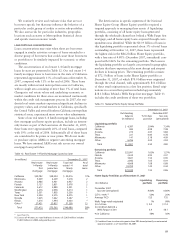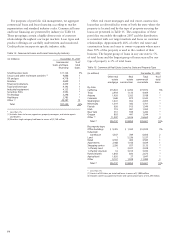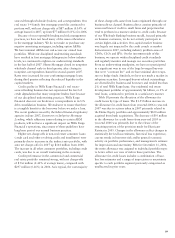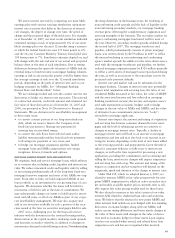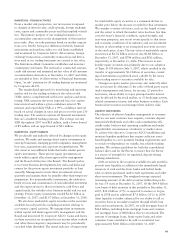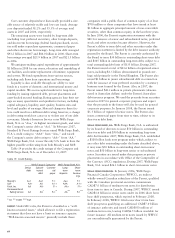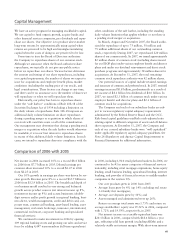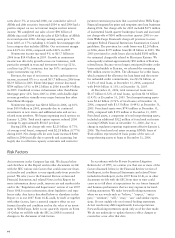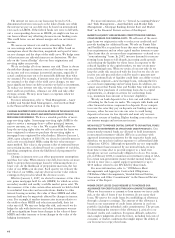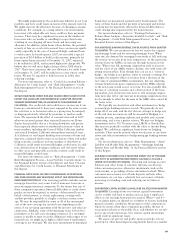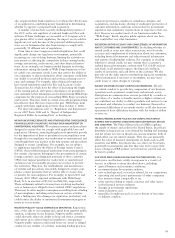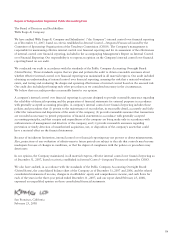Wells Fargo 2007 Annual Report Download - page 66
Download and view the complete annual report
Please find page 66 of the 2007 Wells Fargo annual report below. You can navigate through the pages in the report by either clicking on the pages listed below, or by using the keyword search tool below to find specific information within the annual report.63
MARKET RISK – TRADING ACTIVITIES
From a market risk perspective, our net income is exposed
to changes in interest rates, credit spreads, foreign exchange
rates, equity and commodity prices and their implied volatili-
ties. The primary purpose of our trading businesses is to
accommodate customers in the management of their market
price risks. Also, we take positions based on market expecta-
tions or to benefit from price differences between financial
instruments and markets, subject to risk limits established
and monitored by Corporate ALCO. All securities, foreign
exchange transactions, commodity transactions and deriva-
tives used in our trading businesses are carried at fair value.
The Institutional Risk Committee establishes and monitors
counterparty risk limits. The notional or contractual amount,
credit risk amount and estimated net fair value of all customer
accommodation derivatives at December 31, 2007 and 2006,
are included in Note 16 (Derivatives) to Financial Statements.
Open, “at risk” positions for all trading business are monitored
by Corporate ALCO.
The standardized approach for monitoring and reporting
market risk for the trading activities is the value-at-risk
(VAR) metrics complemented with factor analysis and stress
testing. VAR measures the worst expected loss over a given
time interval and within a given confidence interval. We
measure and report daily VAR at a 99% confidence interval
based on actual changes in rates and prices over the past 250
trading days. The analysis captures all financial instruments
that are considered trading positions. The average one-day
VAR throughout 2007 was $18 million, with a lower bound
of $9 million and an upper bound of $93 million.
MARKET RISK – EQUITY MARKETS
We are directly and indirectly affected by changes in the equity
markets. We make and manage direct equity investments in
start-up businesses, emerging growth companies, management
buy-outs, acquisitions and corporate recapitalizations. We
also invest in non-affiliated funds that make similar private
equity investments. These private equity investments are
made within capital allocations approved by management
and the Board of Directors (the Board). The Board’s policy
is to review business developments, key risks and historical
returns for the private equity investment portfolio at least
annually. Management reviews these investments at least
quarterly and assesses them for possible other-than-temporary
impairment. For nonmarketable investments, the analysis is
based on facts and circumstances of each individual investment
and the expectations for that investment’s cash flows and
capital needs, the viability of its business model and our exit
strategy. Private equity investments totaled $2.02 billion at
December 31, 2007, and $1.67 billion at December 31, 2006.
We also have marketable equity securities in the securities
available-for-sale portfolio, including securities relating to
our venture capital activities. We manage these investments
within capital risk limits approved by management and the
Board and monitored by Corporate ALCO. Gains and losses
on these securities are recognized in net income when realized
and other-than-temporary impairment may be periodically
recorded when identified. The initial indicator of impairment
for marketable equity securities is a sustained decline in
market price below the amount recorded for that investment.
We consider a variety of factors, such as: the length of time
and the extent to which the market value has been less than
cost; the issuer’s financial condition, capital strength, and
near-term prospects; any recent events specific to that issuer
and economic conditions of its industry; and our investment
horizon in relationship to an anticipated near-term recovery
in the stock price, if any. The fair value of marketable equity
securities was $2.78 billion and cost was $2.88 billion at
December 31, 2007, and $796 million and $592 million,
respectively, at December 31, 2006. The increase in mar-
ketable equity securities was primarily due to our adoption
of Topic D-109 effective July 1, 2007, which resulted in the
transfer of approximately $1.2 billion of securities, consist-
ing of investments in preferred stock callable by the issuer,
from trading assets to securities available for sale.
Changes in equity market prices may also indirectly affect
our net income by affecting (1) the value of third party assets
under management and, hence, fee income, (2) particular
borrowers, whose ability to repay principal and/or interest
may be affected by the stock market, or (3) brokerage activity,
related commission income and other business activities. Each
business line monitors and manages these indirect risks.
LIQUIDITY AND FUNDING
The objective of effective liquidity management is to ensure
that we can meet customer loan requests, customer deposit
maturities/withdrawals and other cash commitments effi-
ciently under both normal operating conditions and under
unpredictable circumstances of industry or market stress.
To achieve this objective, Corporate ALCO establishes and
monitors liquidity guidelines that require sufficient asset-
based liquidity to cover potential funding requirements and
to avoid over-dependence on volatile, less reliable funding
markets. We set these guidelines for both the consolidated
balance sheet and for the Parent to ensure that the Parent
is a source of strength for its regulated, deposit-taking
banking subsidiaries.
Debt securities in the securities available-for-sale portfolio
provide asset liquidity, in addition to the immediately liquid
resources of cash and due from banks and federal funds
sold, securities purchased under resale agreements and other
short-term investments. The weighted-average expected
remaining maturity of the debt securities within this portfo-
lio was 5.9 years at December 31, 2007. Of the $69.4 billion
(cost basis) of debt securities in this portfolio at December 31,
2007, $12.0 billion (17%) is expected to mature or be pre-
paid in 2008 and an additional $7.8 billion (11%) in 2009.
Asset liquidity is further enhanced by our ability to sell or
securitize loans in secondary markets through whole-loan
sales and securitizations. In 2007, we sold mortgage loans of
$224 billion, including home mortgage loans and commer-
cial mortgage loans of $48 billion that we securitized. The
amount of mortgage loans, home equity loans and other
consumer loans available to be sold or securitized was
approximately $160 billion at December 31, 2007.




